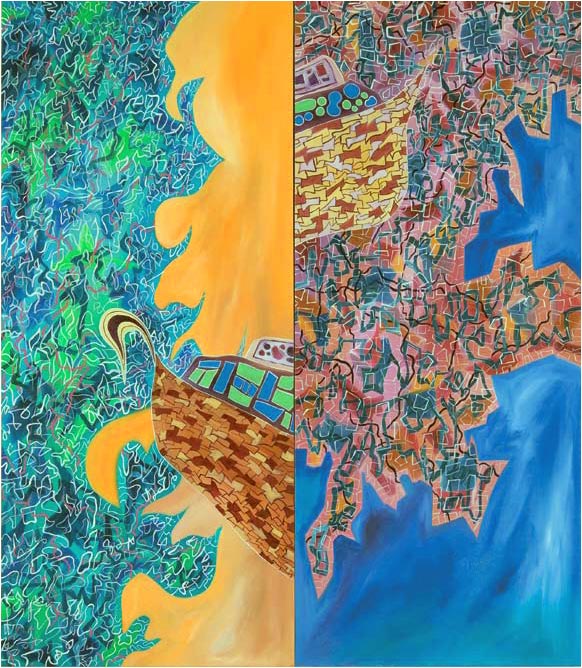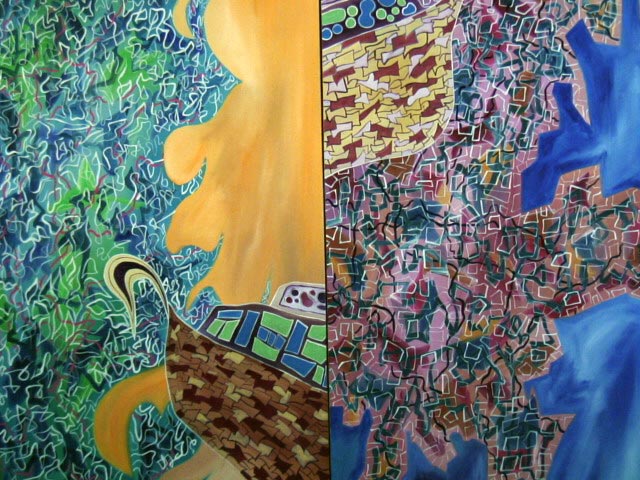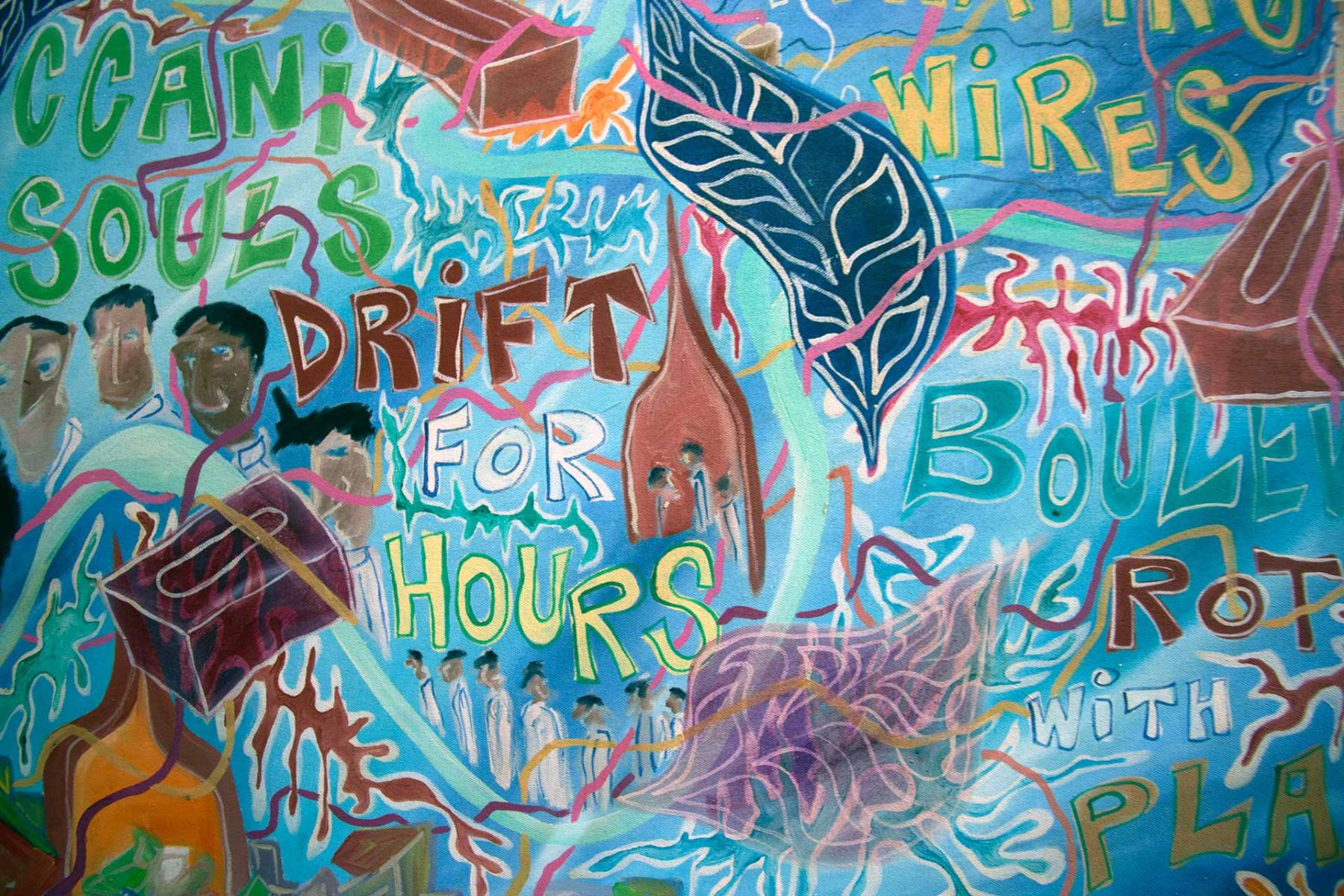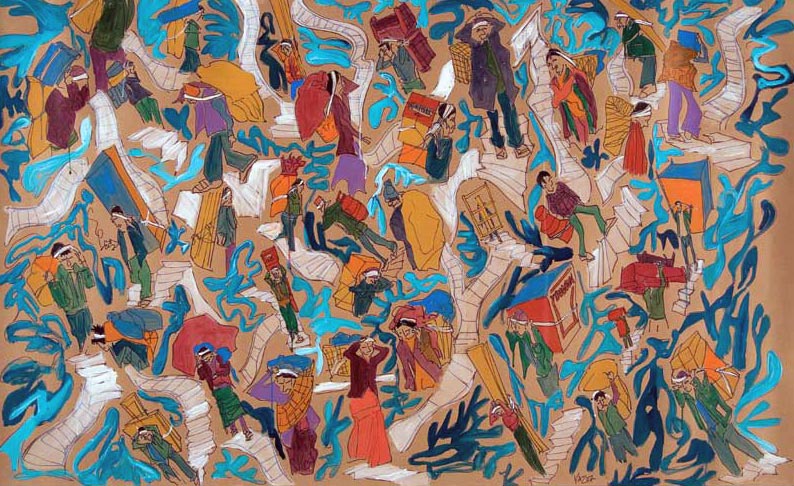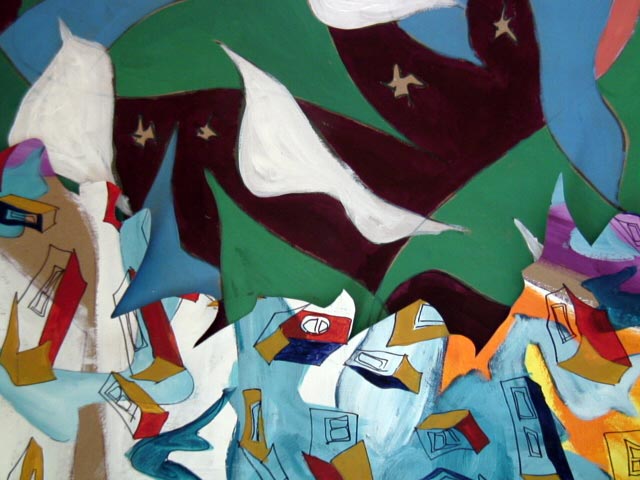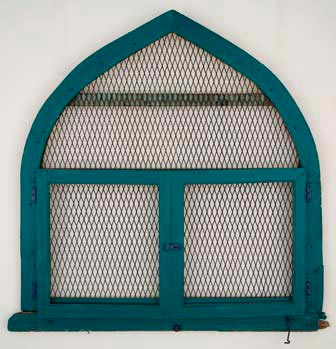
Deccani Ark
BOMBAY ART GALLERY, MUMBAI, INDIA
APRIL 16 – APRIL 25, 2007
Kaz Rahman presents five paintings on canvas, three acrylic works on paper and two arch installation pieces in ‘Deccani Ark’. This new work (2006-07) carries Rahman’s long time agenda that combines contemporary critical and cultural theory with a particular interest in Islamicate regimes of representation.
His art startlingly sees the problems of modern painting in terms of color, composition, point of view and perspective and attempts to offer an alternative reading through Islamic visual culture. He never imitates the so-called ‘Islamic visual forms’ but considers the problems of Islamicate representation and creates his own unique works. His sophisticated reading of Islamicate aesthetics does not lead to imitation, rather through repetition, he explores his own creative way to ground his reading of (post)-modern culture.
Having witnessed Rahman’s other works, it is always an adventure to view work that educates one about art and simultaneously tames and disturbs the eyes and mind. The works in this exhibition have three significant layers: personal experiences, formal challenges to contemporary art and a highly complicated and crafted political attitude.
The proper names used in Rahman’s works- Hyderabad, Ontario, Dhaka- are not accidental but arise from his personal experiences. Dhaka, Hyderabad and Ontario turn into topographical symbol-names that come to represent existential adventures of a young artist who was born in Ontario but is deeply connected to Hyderabad and subjected to a sublime event of a flood in Dhaka. He translates his personal experiences into a medium through which proper names are transformed into symbols of a quest for identity. Stripping personal experience from its psychological burden and solipsistic closure, he skilfully transforms them into sites of imagination. He turns his body from a subjective site of pleasure to a site of contest. The scars of traumatic solitude in Ontario, the grief/nostalgia of ‘homecoming’ in Hyderabad and the helplessness of Dhaka are translated into visual idioms of the illusion of the wholeness of the subject. He cries: “I” have all of them and “I” affirm it. No apology, but a will to face his fractured identity.
Rahman’s never-ending challenge to Eurocentric notions of art is another theme that runs through his works. His challenge is not a simple encounter, it disturbs and transgresses the borders of Eurocentrism through constant references to the corpus of Islamic visual heritage. However he rejects being an apologist for an Islamic art that reproduces the Orientalist constructions. Instead, he problematizes every single point in this notion of art through his imaginative forays: for instance, Rahman’s abstraction is a response to the over-exaggerated notion of abstraction that requires no figures. In his works there is no absolute geometrical abstraction, there are partial abstractions: abstraction of color, abstraction of face, abstraction of figure, abstraction of concepts…
Eurocentric writing on art is based on the very crude idea of iconoclasm in its perception of Islamicate painting practices. Rahman would have preferred not to deal with this problem. However, his challenge does not let things go, instead he chooses to “face” the problem. His almost deformed and de-faced figures, on the one hand show that there is no pure abstraction, and on the other hand that there is no absolute representation. By defacing the figures with flowing and animated movements, he proves that any visual imagination has both restrictions and possibilities but none of them ahistorical and essential. He plays with the limits of abstraction and figuration. As in his preceding works, he rejects the enterprises attempting to restrict Islamic art to calligraphy and discovers the possibilities of letters in the ‘other’s alphabet’. This otherness on the figural level displays that the other cannot be “Other” even if it so desires. By painting his own poem as a part of the work, he questions the limits of painting, calligraphy and poetry.
His challenge continues with color. Rahman’s selection of blue, green, turquoise, orange and red refrains from feminizing the landscape; it is an attempt to revitalize the lively selection of colors in classical miniature painting. Composition that requires the almost geometrical formal division of medium does not find any place in Rahman’s works. The minute figures, very detailed contour of bodies, and the nearly defaced people, all pay tribute to the Islamicate picturing traditions. In Orientalist literature, this can be seen as an ‘horror vacui’. However, he challenges the notions of repetition by filling the space with these figures as proof of his awareness of the problem.
Landscape and Flood: two powerful concepts that bind the exhibition together. Rahman’s attitude towards the experience of the flood-event is a resistance to the modern understanding of catastrophe. Flood is not a messianic moment of doom, but a humane experience that should be dealt with peacefully. At first glance, his depiction of the ‘catastrophic scenes’ seem to carry a debt to the landscape genre. However, he does not situate the scenes of catastrophe into a sublime context which creates the illusion of an overpowering force that leaves one speechless. Rather as in the arch-examples of Hamzanama, he understands the catastrophe as an epic adventure that tells a human story without forgetting its daily communication with the divinity. In this context ‘flood as a visual concept’ is raised as a critique of the western tradition of landscape painting. Rahman does not present the landscape in a picturesque style, rather he depicts it as a corporeal communication between the artist and his immediate environment. He is not the spectator, nor the painter of the catastrophe. Rahman translates his immediate experience into the visual space. He neither exaggerates nor belittles…
Rahman’s visual style incorporates a political gesture that does not cheer but incorporates the political attitude visually. His political awareness does not suppress his artistic expression. He paints his political agenda. Politics, in Rahman’s art, is not a profession that belongs to others but a permanent ontological deed of human beings. By distancing himself from the picturesque landscape, he historicizes the flood. It happened in Dhaka and he experienced it; this is neither a coincidence nor an abstract notion. Flood is a scar in the exhibition; it turns the abstract notion of flood into a corporeal, phenomenological experience that happens in a specific place, at a specific time, to a specific people. This singularity concretizes the catastrophe and embodies it on a site. Ontario and Dhaka work against each other at this level. The works force the viewer to see the political difference between Ontario and Dhaka. This non-propagandist language of politics is the power of Rahman’s visual language.
As opposed to ‘classical’ landscapes, he thrusts human artifacts into the paintings. These artifacts function almost as an alienation effect that calls the viewer back to the reality of contemporary life. This prevents him from romanticizing the event and instead allows him to present the real effects of the real disaster on a highly abstract level. He does not let the awe in the work capture you, he keeps reminding the viewer that a new start and hope will always be there. ‘Fajr’ is an offer. It is a promise. It is water that maintains and guarantees the possibility of hope. This hope is supported by the warm colors of the new beginning.
Nuh Yilmaz (Washington DC March, 2007)
